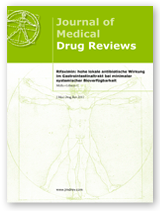
Das Journal of Medical Drug Reviews ist ein "Open Access"-Journal. Alle Artikel können für die persönliche Information des einzelnen Nutzers kostenlos heruntergeladen werden. Hingegen ist für eine kommerzielle Nutzung der Inhalte dieses Journals in jedwedem Medium die schriftliche Genehmigung des Verlages zwingend erforderlich. Das Urheberrecht liegt ausschließlich beim Verlag Reprint Publications GmbH & Co. KG.
© Reprint Publications 2016,
Webdesign Bothgrafik,
Programmierung amr
Certolizumab Pegol – Pegyliertes anti-TNFa Fab'-Fragment mit schneller Wirksamkeit bei rheumatoider Arthritis, axialer Spondyloarthritis und Psoriasis-Arthritis
J Med Drug Rev 2014;4:85–93Abstract
Certolizumab Pegol ist das einzige pegylierte anti-TNFa Fab'-Fragment zur subkutanen Anwendung bei rheumatoider Arthritis, axialer Spondyloarthritis und Psoriasis-Arthritis. Der Antikörper enthält keine Fc-Region, die in vitro mit Apoptose, Komplementaktivierung und zytotoxischen Effekten assoziiert ist. Die Bindung an Polyethylenglykol verlängert die Halbwertszeit und macht die Substanz stabiler und wasserlöslicher, so dass eine subkutane Behandlung in 2- oder 4-wöchigen Intervallen möglich ist.
Die RAPID-Studien untersuchten Certolizumab Pegol 200 mg alle 2 Wochen nach Initialtherapie von 400 mg in Woche 0, 2 und 4 subkutan in Kombination mit Methotrexat in der Indikation rheumatoide Arthritis. Rund zwei Fünftel der Certolizumab Pegol-Patienten hatten nach 24 Wochen ein ACR50-Ansprechen. Bereits nach einer Woche sprachen signifikant mehr Patienten an als mit Placebo. Certolizumab Pegol hemmte die radiologische Progression der Gelenkveränderungen und reduzierte die Krankheitsaktivität (DAS28).
Bei axialer Spondyloarthritis reduzierte Certolizumab Pegol subkutan (200 mg alle 2 Wochen/400 mg alle 4 Wochen nach Initialtherapie mit 400 mg in Woche 0, 2 und 4) die Symptome bei guter Verträglichkeit schnell und effektiv. Bereits in Woche 1 hatten signifikant mehr Certolizumab Pegol-Patienten ein ASAS20-Ansprechen als mit Placebo. Nach 12 Wochen betrugen die ASAS20-Ansprechraten mit 200 mg/2 Wochen bzw. 400 mg/4 Wochen Certolizumab Pegol 57,7 % bzw. 63,6 % versus 38,3 % mit Placebo (p < 0,001). Das Ansprechen auf Certolizumab Pegol war vom radiologischen Ausgangsbefund unabhängig, Patienten mit Spondylitis ankylosans und Patienten mit radiologisch negativer axialer Spondyloarthritis profitierten in vergleichbarer Weise.
Bei Psoriasis-Arthritis war Certolizumab Pegol subkutan (200 mg alle 2 Wochen oder 400 mg alle 4 Wochen nach Initialtherapie mit 400 mg in Woche 0, 2 und 4) ebenfalls schnell wirksam und effektiv: In Woche 12 hatten 58,0 % bzw. 51,9 % der Patienten ein ACR20-Ansprechen im Vergleich zu 24,3 % mit Placebo (p < 0,001). Bis Woche 24 erreichten 74 % der Patienten einen PASI50 und 47 % einen PASI90, die zur Baseline einen Befall von wenigstens 3 % der Körperoberfläche aufwiesen. Häufigkeit und Schweregrad von Enthesitis und Daktylitis nahmen im Vergleich zu Placebo signifikant ab.
Certolizumab Pegol wurde allgemein gut vertragen. Häufigste Nebenwirkungen in allen Zulassungsstudien waren Infektionen.
Schlussfolgerung: Certolizumab ist eine verträgliche und effektive Behandlungsoption für rheumatoide Arthritis, axiale Spondyloarthritis und Psoriasis-Arthritis. Innerhalb weniger Wochen führt Certolizumab zu einer deutlichen Reduktion der Symptomatik.
Certolizumab Pegol - Pegylated anti-TNF-α Fab' fragment with rapid efficacy in rheumatoid arthritis, axial spondyloarthritis and psoriatic arthritis
Certolizumab pegol is the only pegylated anti-TNF-α Fab' fragment for subcutaneous application in rheumatoid arthritis, axial spondyloarthritis and psoriatic arthritis. This antibody does not include a Fc-region, which is associated in vitro with apoptosis, complement activation and cytotoxic effects. The binding to polyethylene glycol prolongs the half-life and increases stability and water solubility enabling subcutaneous treatment intervals of 2 or 4 weeks.
The RAPID studies investigated certolizumab pegol 200 mg every 2 weeks, after initial treatment with 400 mg in week 0, 2 and 4 subcutaneously in combination with methotrexat in rheumatoid arthritis. About two fifth of the certolizumab patients showed an ACR50 response after 24 weeks. Already after one week, significantly more patients had a response compared to the placebo group. Certolizumab pegol inhibited the radiographic progression of structural joint damage and reduced the disease activity.
In patients with axial spondyloarthritis, certolizumab pegol subcutaneously (200 mg every two weeks/400 mg every 4 weeks after initial treatment with 400 mg in week 0, 2 and 4) reduced the symptoms rapidly and effectively together with a good tolerability. Already in week 1, significantly more certolizumab pegol patients had an ASAS20 response than placebo patients. After 12 weeks, the ASAS20 response rates with 200 mg every two weeks and 400 mg every 4 weeks certolizumab pegol were 57.7% resp. 63.6% compared to 38.3% with placebo (p < 0.001). The response to certolizumab pegol did not correlate with the radiographic baseline status, patients with ankylosing spondylitis and patients with non-radiographic axial spondyloarthritis benefited in a similar way.
In patients with psoriatic arthritis, certolizumab pegol subcutaneously (200 mg every two weeks or 400 mg every 4 weeks after initial treatment with 400 mg in week 0, 2 and 4) was rapidly active and effective as well: In week 12, 58.0% resp. 51.9% of patients had an ACR20 response compared with 24.3% with placebo (p < 0.001). Until week 24, 74% of patients with at least 3% of the body surface affected at baseline achieved a PASI50 and 47% a PASI90. Frequency and severity of enthesitis and dactylitis decreased significantly compared with placebo.
Generally, certolizumab was tolerated well. Most frequently observed side-effects in the pivotal studies were infections.
Conclusion: Certolizumab is a well-tolerated and effective treatment option in rheumatoid arthritis, axial spondyloarthritis and psoriatic arthritis. Within a few weeks, certolizumab treatment resulted in a markedly improved symptomatology.

